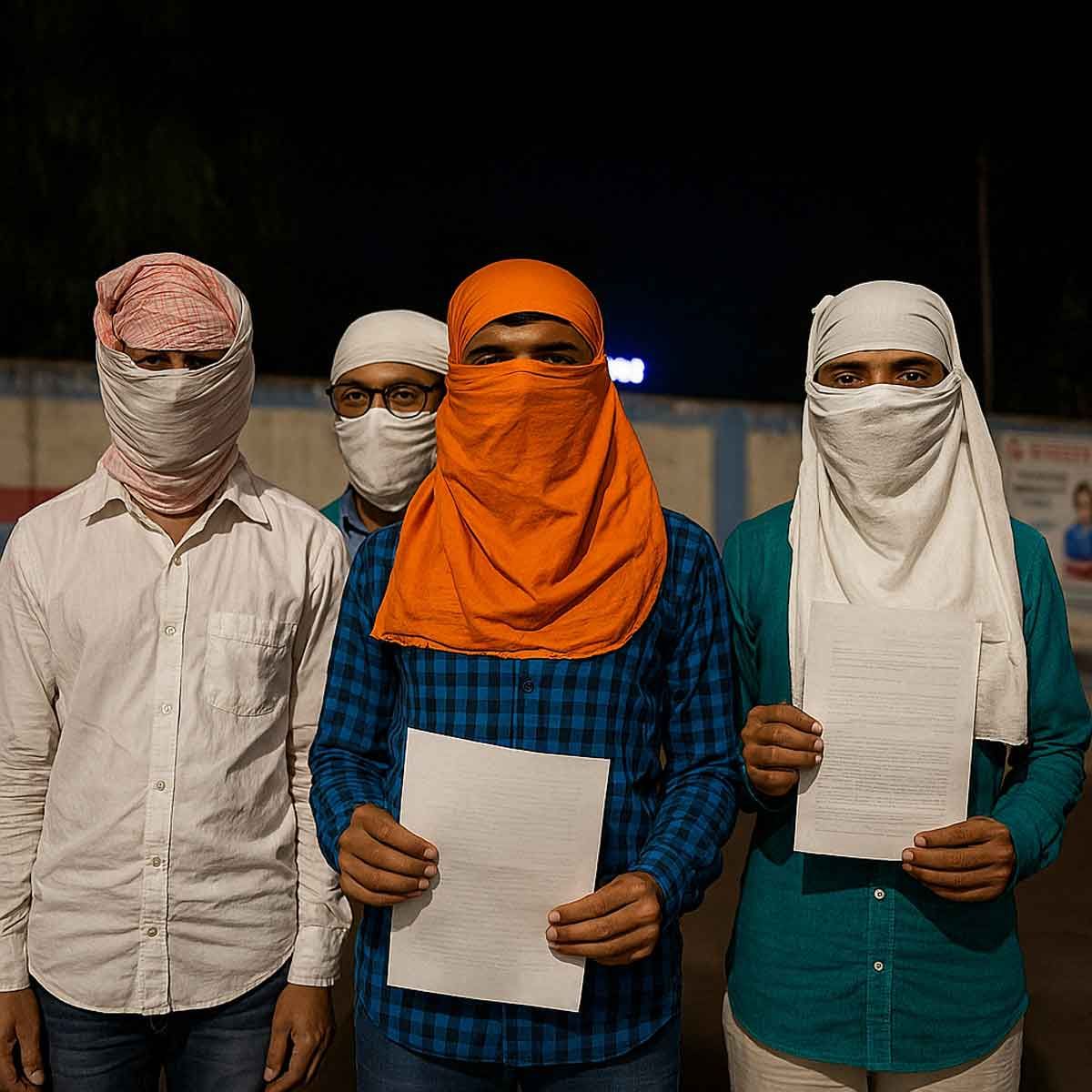More Coverage
Twitter Coverage
Satyaagrah
Written on
Satyaagrah
Written on
Satyaagrah
Written on
Satyaagrah
Written on
Satyaagrah
Written on
JOIN SATYAAGRAH SOCIAL MEDIA
Sam Pitroda, draped in a cloak of telecom innovation, yet mired in ₹150 crore C-DoT scandal and exposed by the Nambiar Committee; a story of Congress-crafted illusion, where financial irregularities & political puppetry overshadowed technological promises

In the realm of Indian politics, the trajectory of Sam Pitroda, Congress leader and Chairman of the Indian Overseas Congress, provokes both curiosity and criticism. When one peers into Pitroda's past, a question looms: has his career been a story of genuine accomplishment, or a series of opportunistic ventures masked as public service?
Let's dive into the past. Between 1984 and 1990, a period marked by rapid technological advancements, Sam Pitroda held the influential roles of Chairman of the Telecom Commission and secretary of the Department of Telecom. It was a pivotal time for India's telecom sector, yet Pitroda's tenure is marred by allegations of considerable financial mishandling. Reportedly, Pitroda's actions, shrouded in promises of progress, cost India a staggering Rs 150 crore. This hefty sum, a burden on the nation's treasury, raises questions about his integrity and managerial acumen. Was this period a missed opportunity for India's telecom revolution, squandered under Pitroda's watch?
Fast-forward to the present, and Pitroda's recent statements add another layer of controversy to his already contentious public image. On 27th December, he made comments about the Ram Mandir, a subject deeply interwoven with India's religious and cultural fabric. His words, "too much importance is being given to religion through the Ram Mandir and that democracy is being undermined," strike a discordant note. He continued, “Everyone is talking about a Hindu temple. Everyone talks about Lord Ram. This is not how you build a modern nation.” These remarks, seemingly dismissive of Hindu sentiments, have sparked a fresh wave of criticism.
But Pitroda didn't stop there. The very next day, he delved into the controversial topic of Electronic Voting Machines (EVMs). In an interview, he speculated about the 2024 Lok Sabha elections, suggesting that the BJP might win 400 seats if EVMs are not 'fixed'. This statement, coming from a leader of his stature, not only casts unwarranted aspersions on the electoral process but also seems to prepare ground for justifying potential electoral defeats.
Sam Pitroda's political narrative is increasingly resembling a tragicomedy of errors. His recent concession of defeat to the BJP, tainted by allegations of EVM tampering, is just the tip of the iceberg. This statement, rather than being a humble admission of anticipated loss, seems more like a preemptive excuse, casting shadows of doubt over the electoral process without substantial evidence.
|
Delving deeper into Pitroda's history of public statements, one finds a trail of comments that range from the insensitive to the outrageous. A self-proclaimed Gandhi-Congress loyalist, his remarks often appear disconnected from the sensibilities and sentiments of the very people he represents. His controversial takes include making light of the Pulwama attack, a national tragedy, and casting doubts on the Balakote airstrikes, a critical moment in India's defense narrative. These instances reflect a tendency to trivialize matters of national security and valor.
Pitroda's repertoire of contentious comments doesn't end there. His habit of insulting Hindu temples and comparing India's Prime Minister to Hitler showcases a penchant for hyperbole and historical distortion. Such analogies are not just historically inaccurate but also deeply disrespectful and inflammatory. His defense of Rahul Gandhi's India-critical statements on foreign soil and his shielding of Pakistan in political discourse further add to the narrative of him being out of touch with national sentiment.
Perhaps the most chilling of his statements relate to the 1984 anti-Sikh riots, a dark chapter in India's history. His casual dismissal of the tragedy with the words, “Ab kya hai ’84 ka? Aapne kya kiya 5 saal mein, uski baat kariye. ’84 mein hua to hua. Aapne kya kiya? (now what about ’84? What did you do in 5 years, talk about that. What happened in ’84 had happened. What did you do?)”, betrays a startling insensitivity. This attempt to downplay the gravity of the riots, where thousands of Sikhs lost their lives, is not just a gross oversight but a blatant disregard for human suffering and historical accountability.
Who is Sam Pitroda? A Critical Look at His Journey and Allegiances
Sam Pitroda, often seen as a figure tethered to the Congress party's legacy, presents a complex character in the tapestry of Indian politics. Born as Satyan Gangaram Pitroda in Orissa's Titilagarh in 1942, his life journey took a significant turn when he moved to the United States in 1964. This move, marking the start of his international career, was just the beginning of a life that would later intertwine closely with Indian politics.
Pitroda's connection with the Congress leadership dates back to the era of Indira Gandhi. It was in 1981 that he first met then Prime Minister Indira Gandhi, focusing on discussions about the development of India's telecom sector. His involvement with the Congress took a more substantial turn in 1987 when he became an advisor to Rajiv Gandhi, Indira's son. During this tenure, he spearheaded six technology missions and led the Telecom Commission and Department of Telecom.
But one must ponder, is Pitroda's dedication solely to the advancement of technology and the country, or is it more deeply rooted in his allegiance to the Gandhi family? His own admission of having a “bond with Rahul Gandhi” adds to this narrative. It seems that his loyalty to the Gandhi-Congress has been unwavering over the years, but it raises a critical question: does this loyalty stem from a genuine belief in their vision for India, or is it more a case of political opportunism?
An intriguing aspect of Pitroda's story is his decision to give up his US citizenship to become a Minister of State in Rajiv Gandhi's government. He described this as “a most painful decision,” revealing a deep attachment to the United States. His acknowledgment, "The US has given me all the tools I need to do what I do," further underscores this sentiment. This statement perhaps unwittingly reveals a conflict of interests at the heart of Pitroda's political journey. While he was asked by Rajiv Gandhi to become the technology minister, one wonders if his heart ever truly left the United States, the country that shaped his professional identity.
A decorated Gandhi-Congress loyalist hiding behind a self-declared ‘Telecom czar’ disguise?
Sam Pitroda, known for his role in India's telecom sector, has crafted an impressive public image. On his website and in his book 'The March of Mobile Money', he is lauded as “the man behind India’s telecom revolution”. This narrative is echoed in various media reports, one of which says, “In India, Pitroda is big – in a Bill Gates sort of way – regaled with titles like “technology guru” and “telecom czar.”
However, the glamour surrounding Pitroda's persona as a telecom visionary is not without its darker shades. The story behind this self-styled 'Telecom czar' is not just a tale of technological advancement but also one marred by controversy and accusations.
In the pivotal year of 1984, under the Rajiv Gandhi government, Pitroda established C-DoT, the Centre for Development of Telematics. This initiative was initially viewed as a significant step towards modernizing India's telecom infrastructure. However, by 1990, a different narrative began to emerge, casting a shadow over Pitroda's achievements.
Allegations surfaced suggesting that C-DoT was misused for personal gains. It was claimed that Pitroda used C-DoT to favor his own companies in the US and to place preferred candidates in key positions. There were also accusations of false progress reports being circulated about C-DoT.
The controversy deepened with allegations that Pitroda flouted government norms in importing equipment for telecom projects. Deals were reportedly struck between two of his companies, Martek and Micro Technology Inc, and C-DoT, in clear violation of rules prohibiting government servants from awarding contracts to their own companies.
The fallout from these allegations saw two of Pitroda’s close aides at C-DoT, GB Meemansi and DR Mahajan, being dismissed by the government. This period also witnessed the release of the Nambiar Committee report, set up to assess C-DoT’s performance, likely adding more layers to the controversy surrounding Pitroda.
|
The Nambiar Committee report, signed by 9 members, with dissenting views from Pitroda's aides Meemansi and Mahajan, provides a glimpse into this complex saga. These aides were accused of hand-picking C-DoT staff, likely to ensure loyalty and prevent dissent – a move that raises questions about the integrity of the organization under Pitroda's leadership.
What stands out as particularly astonishing is Pitroda's transformation over the years. From being entrenched in the bureaucratic structure he later criticized, to portraying himself as a beleaguered champion of telecom in India, Pitroda's narrative is one of self-styled heroism amidst an allegedly flawed system.
As secretary of the Department of Telecom, Pitroda found himself in a peculiar situation when it came to the Nambiar Committee report. This report, critical of C-DoT's functioning, was to be examined by the Ministry of Communications before being presented in Parliament. However, as a senior telecom official pointed out, “But how can Unnikrishnan allow Pitroda as secretary of the department to examine a report which is against him?” This posed a clear conflict of interest, hindering the report's journey to the parliamentary table.
Further complicating matters, Communications Minister Unnikrishnan was unable to present the Nambiar report in Parliament, despite the report dismissing charges of financial irregularities. This situation reflects the convoluted and sometimes impenetrable nature of bureaucratic processes, especially when high-ranking individuals like Pitroda are involved.
Reports also suggest that Pitroda enjoyed a unique level of autonomy and power, unlike other government secretaries. He reportedly wasn’t bound by standard service rules and couldn't be easily removed from his position, having been appointed as the Telecom Commission chairman by a cabinet resolution. This extraordinary level of protection raises eyebrows, suggesting a level of untouchability within the governmental hierarchy.
Adding to the mystery, the terms and conditions of Pitroda's appointment were apparently not documented in government files, leaving only the option of a charge sheet to hold him accountable. This lack of transparency in documenting his role points to a potential manipulation of bureaucratic norms for personal advantage.
|
The Nambiar report, while dismissing financial irregularity charges, did criticize C-DoT for failing to meet its promise of starting commercial production of a 40,000 line exchange by 1987, a commitment made in 1984. Additionally, it highlighted C-DoT's unfulfilled promise to develop an exchange capable of handling 800,000 busy-hour call attempts.
One striking revelation from the report is that C-DoT had to start from scratch in designing a large electronic switching system. The ambitious goals of creating exchanges capable of handling 40,000 and 800,000 lines were far from reality. Even a modest 5,000-line exchange was not expected to be ready for commercial production before 1992-93. This delay and deviation from the original plan highlight a significant failure in delivering on promises.
This two and half year delay had severe financial implications, causing the Indian Telephone Industries (ITI) a revenue loss of Rs 150 crore. Even Pitroda’s close aides couldn't deny the fact that C-DoT was lagging behind its schedule. In a dissent report, it was conceded that C-DoT had not yet developed critical components for the large exchange, including the central module and the input-output processor, essential for connecting exchanges and storing billing information, respectively.
Adding to the woes, C-DoT downgraded its specifications for busy-hour call attempts from 2.8 lakhs in 1986 to 1.8 lakh in 1990. This reduction was justified with the reasoning that “the country does not require such an exchange today”, a statement that seems more like a convenient excuse for underperformance than a strategic decision.
Pitroda's defense to these shortcomings was reportedly that he had only committed to beginning field trials by 1987, with the aim of eventual commercial production. He claimed that this promise was misinterpreted, an assertion that appears to be an attempt at shifting blame rather than accepting responsibility.
|
The report also points out other dubious activities under Pitroda's watch. More than 36 manufacturers were licensed to produce an instrument that was not part of C-DoT's original mandate. This unnecessary expansion raises questions about the rationale behind such decisions. Furthermore, C-DoT manufacturers were reported to be working below capacity, suggesting inefficiency and mismanagement.
Perhaps more troubling is the appointment of 11 foreign consultants, most of whom were reportedly close friends of Pitroda, to develop software. This nepotistic approach not only casts doubts on the integrity of the hiring process but also on the quality of the expertise brought in.
In a striking instance, Roy Mehta, a close friend of Pitroda from the US, received a hefty sum of Rs 41.64 lakh as consultancy fees. Additionally, foreign firms and individuals were paid Rs 1.29 crore for consultancy services. These hefty payouts, especially to Pitroda's acquaintance, raise serious questions about the integrity and objectivity of the consultancy process.
Further controversy surrounds the Telecom Commission's inaction against the French firm Alcatel. Despite an agreement from 1982, where Alcatel was supposed to upgrade the technology it provided to India free of cost, the Commission, under Pitroda’s leadership, failed to enforce this agreement. This lax attitude towards a significant technological commitment reflects poorly on the Commission's dedication to advancing India's telecom infrastructure.
Ironically, C-DoT, under Pitroda's direction, signed a staggering Rs 4 crore agreement with US-based Trans Tech for developing cellular phones. This move is particularly jarring given Pitroda's previous criticism of the project as being "elitist." His flip-flop on this issue, from criticizing to endorsing such a project, smacks of hypocrisy and a lack of consistent vision.
| For decades he is being whitewashed, and always appear during Elections |
This accusation of elitism in the telecom sector during the Rajiv Gandhi government was further echoed in a 1989 report by the Economic and Political Weekly. An excerpt from the report poignantly captures the essence of this criticism: “The elitist orientation of the management of the telephone services was indeed embodied in the very charter of the Mahanagar Telephone Nigam. This is very much in tune with the overall development philosophy of the present establishment which, besides its many other features, has a marked weakness for spectacles and extravaganzas at selected points while the national scene as a whole remains drab and depressing.”
This statement sharply critiques the approach of the telecom sector under Pitroda's stewardship. It implies that while there was a focus on high-profile, extravagant projects that benefitted a select few, the broader landscape of national development and inclusive progress was largely neglected.
The report notes, “Sam Pitroda himself is known to enjoy the confidence and support of the prime minister. His position as the prime minister’s technology advisor with the rank of minister of state has given him stature and clout in the ruling coterie. His appointment as secretary of the department of telecommunication by virtue of which he is also the chairman of the Telecommunications Commission is, however, protocol-wise rather odd.” This statement underscores the unique and perhaps unorthodox positioning of Pitroda within the governmental hierarchy. While his close association with the Prime Minister conferred upon him significant influence, it also created an unusual situation where his role as a departmental secretary was elevated to the rank of a minister. This unconventional arrangement raises questions about the transparency and propriety of bureaucratic structures and appointments.
Further criticism is directed at Pitroda's approach to foreign collaborations and import policies. While he actively engaged foreign manufacturers and consultants, potentially favoring his own companies, he simultaneously opposed the import of telephone systems from diverse international sources like Japan, France, and Sweden. This contradictory stance suggests a potential conflict of interest, where personal or nationalistic biases may have influenced policy decisions, limiting India's access to varied and potentially beneficial telecom technologies.
The report's most telling revelation, however, is Pitroda's own admission of his limited understanding of Indian society and the political and social dynamics within the country. The report states that Pitroda “readily admits that he has little understanding of Indian society and is not even a serious student of the social and political forces at play in India.” This acknowledgment is startling, considering the significant role he played in a sector as vital as telecommunications, which deeply intersects with social and economic aspects of society. His admission not only highlights a disconnect from the Indian context but also raises doubts about the depth and relevance of his contributions to a sector that is fundamentally intertwined with the societal fabric.
In conclusion, Sam Pitroda's journey through the corridors of Indian telecom policy appears to be marked by a series of unconventional decisions, conflicting interests, and a profound disconnect from the societal realities of the nation he aimed to serve. His narrative, once painted as a success story of technological advancement, now seems overshadowed by questions of propriety, relevance, and alignment with the broader goals of national development and inclusive progress.
 |
 Support Us
Support Us
Satyagraha was born from the heart of our land, with an undying aim to unveil the true essence of Bharat. It seeks to illuminate the hidden tales of our valiant freedom fighters and the rich chronicles that haven't yet sung their complete melody in the mainstream.
While platforms like NDTV and 'The Wire' effortlessly garner funds under the banner of safeguarding democracy, we at Satyagraha walk a different path. Our strength and resonance come from you. In this journey to weave a stronger Bharat, every little contribution amplifies our voice. Let's come together, contribute as you can, and champion the true spirit of our nation.
 |  |  |
| ICICI Bank of Satyaagrah | Razorpay Bank of Satyaagrah | PayPal Bank of Satyaagrah - For International Payments |
If all above doesn't work, then try the LINK below:
Please share the article on other platforms
DISCLAIMER: The author is solely responsible for the views expressed in this article. The author carries the responsibility for citing and/or licensing of images utilized within the text. The website also frequently uses non-commercial images for representational purposes only in line with the article. We are not responsible for the authenticity of such images. If some images have a copyright issue, we request the person/entity to contact us at This email address is being protected from spambots. You need JavaScript enabled to view it. and we will take the necessary actions to resolve the issue.
Related Articles
- Rahul Gandhi claims he hadn’t heard of ‘lynching’ before 2014: Time to revisit India’s bloodied history featuring his family members
- Retd Commander VK Jaitly admits that he was a witness to Rajiv and Sonia Gandhi using INS Viraat to vacation on Lakshwadeep
- How Political ambitions of the Congress has silenced contributions of uncountable freedom fighters
- "BJP has spread kerosene all over the country. You need one spark and we'll be in big trouble": A Criminal psychology study of Rahul Gandhi statement using Kerosene and link of "SAFFRON TERROR” word coined by that time ISI chief
- If Modi’s ‘Vaccine Diplomacy’ wrong, Sonia Gandhi’s ‘Eurozone Bailout’ wrong
- "बताया तो था": Kerala's Wayanad district reels from devastating landslides; 150 dead, with Army, Navy, Air Force, and NDRF joining forces to tackle the aftermath in hard-hit Meppadi panchayat villages like Mundakkai, Chooralmala, Attamala, and Noolpuzha
- Congress Govt in Rajasthan has erased evidence from the spot where the specially-abled minor girl was found abandoned at Tijara flyover in Alwar: NCW chief says FIR should be lodged against Rajasthan govt
- Gujaratis are agitated and are taking PM Modi’s security breach in Congress-ruled Punjab personally: In their hearts, Modi is still ‘their man’
- Hindutvawadi chaku piche se chati pe marega: Rahul Gandhi’s calculated analysis on absolute bullshit
- Taking a swift U-turn Priyanka Gandhi Vadra said that her declaration as a Congress’ CM candidate for UP was a “statement made in irritation" because the media were asking the same question again and again
- Truth of Rahul Gandhi at Cambridge University event to speak at “India at 75": Organised by Congress affiliate organisation “Bridge India”, partner outfit stuffed with Congress leaders, Oxfam and Amnesty connections
- "बने चाहे दुश्मन ज़माना हमारा": US diplomats engage with Indian opposition leaders like Kharge, Owaisi and Omar Abdullah, raising alarms of interference similar to political dynamics in Bangladesh, as Jammu and Kashmir braces for pivotal Assembly Elections
- Gandhi-scion Rahul Gandhi in London promotes anarchy, calls for “mass action” against the Indian state that has been captured: Mirrors Left's playbook, says 'necessary to free the institutions that are controlled by RSS'
- New York Times seems to be the favorite source of information for Rahul Gandhi and the Congress party for developing twisted narratives and targeting the Modi government on Pegasus yet again: How they are wrong
- Sam Pitroda, the ideological guru behind Congress policies and a key advisor to Rahul Gandhi, has dramatically resigned as Overseas Congress chief after his attempt to color-code Indians based on region sparked a national uproar and left many seeing red





























